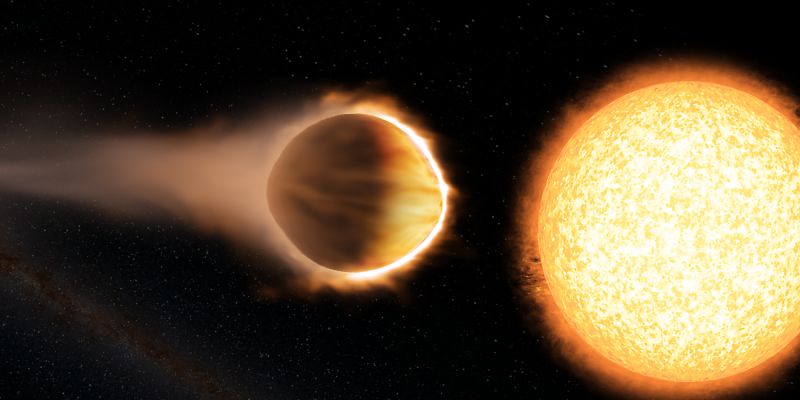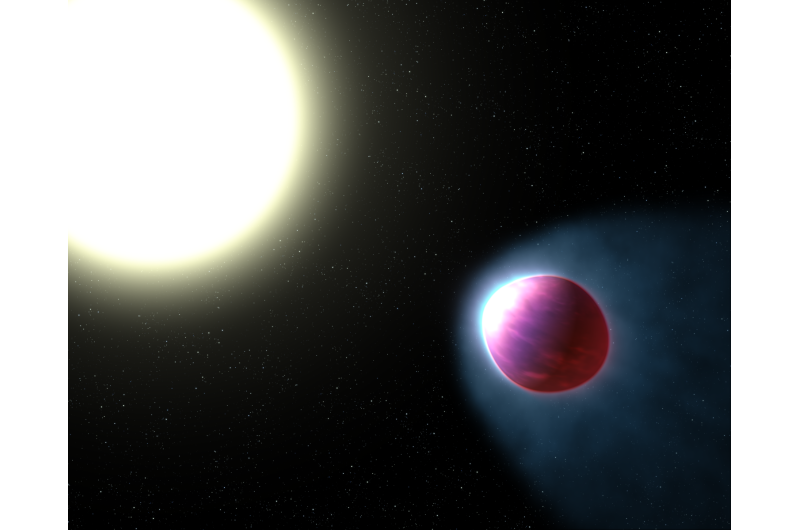Hubble detects exoplanet with glowing water atmosphere

Scientists have found the strongest evidence to date for a stratosphere on an enormous planet outside our solar system, with an atmosphere hot enough to boil iron.
An international team of researchers, led by the University of Exeter, made the new discovery by observing glowing water molecules in the atmosphere of the exoplanet WASP-121b with NASA's Hubble Space Telescope.
In order to study the gas giant's stratosphere - a layer of atmosphere where temperature increases with higher altitudes - scientists used spectroscopy to analyse how the planet's brightness changed at different wavelengths of light.
Water vapour in the planet's atmosphere, for example, behaves in predictable ways in response to different wavelengths of light, depending on the temperature of the water. At cooler temperatures, water vapour in the planet's upper atmosphere blocks light of specific wavelengths radiating from deeper layers towards space. But at higher temperatures, the water molecules in the upper atmosphere glow at these wavelengths instead.
The phenomenon is similar to what happens with fireworks, which get their colours from chemicals emitting light. When metallic substances are heated and vaporized, their electrons move into higher energy states. Depending on the material, these electrons will emit light at specific wavelengths as they lose energy: sodium produces orange-yellow and strontium produces red in this process, for example.
The water molecules in the atmosphere of WASP-121b similarly give off radiation as they lose energy, but it is in the form of infrared light, which the human eye is unable to detect.
The research is published in leading scientific journal Nature.
"Theoretical models have suggested that stratospheres may define a special class of ultra-hot exoplanets, with important implications for the atmospheric physics and chemistry," said Dr Tom Evans, lead author and research fellow at the University of Exeter. "When we pointed Hubble at WASP-121b, we saw glowing water molecules, implying that the planet has a strong stratosphere."
WASP-121b, located approximately 900 light years from Earth, is a gas giant exoplanet commonly referred to as a 'hot Jupiter', although with a greater mass and radius than Jupiter, making it much puffier. The exoplanet orbits its host star every 1.3 days, and is around the closest distance it could be before the star's gravity would start ripping it apart.
This close proximity also means that the top of the atmosphere is heated to a blazing hot 2,500 degrees Celsius - the temperature at which iron exists in gas rather than solid form.

In Earth's stratosphere, ozone traps ultraviolet radiation from the sun, which raises the temperature of this layer of atmosphere. Other solar system bodies have stratospheres, too - methane is responsible for heating in the stratospheres of Jupiter and Saturn's moon Titan, for example. In solar system planets, the change in temperature within a stratosphere is typically less than 100 degrees Celsius. However, on WASP-121b, the temperature in the stratosphere rises by 1000 Celsius.
"We've measured a strong rise in the temperature of WASP-121b's atmosphere at higher altitudes, but we don't yet know what's causing this dramatic heating," says Nikolay Nikolov, co-author and research fellow at the University of Exeter. "We hope to address this mystery with upcoming observations at other wavelengths."
Vanadium oxide and titanium oxide gases are candidate heat sources, as they strongly absorb starlight at visible wavelengths, similar to ozone absorbing UV radiation. These compounds are expected to be present in only the hottest of hot Jupiters, such as WASP-121b, as high temperatures are required to keep them in the gaseous state.
Indeed, vanadium oxide and titanium oxide are commonly seen in brown dwarfs, 'failed stars' that have some commonalities with exoplanets.
Previous research spanning the past decade has indicated possible evidence for stratospheres on other exoplanets, but this is the first time that glowing water molecules have been detected, the clearest signal yet for an exoplanet stratosphere.
It is one of the first results to come out of a new observing program being carried out by an international team of scientists, led by Associate Professor David Sing at the University of Exeter and Dr. Mercedes Lopez-Mórales at the Smithsonian Institution. The program has been awarded 800 hours to study and compare 20 different exoplanets, representing one of the largest time allocations for a single program in the entire 27 year history of Hubble.
"This new research is the smoking gun evidence scientists have been searching for when studying hot exoplanets. We have discovered this hot Jupiter has a stratosphere, a common feature seen in most of our solar system planets." says Professor David Sing, co-author and Associate Professor of Astrophysics at the University of Exeter.
"It's a truly exciting find as we're seeing dramatic differences planet-to-planet which is giving valuable clues in figuring out how planets behave under different conditions, and we're only just scratching the surface of all the new Hubble data."
NASA's forthcoming James Webb Space Telescope will be able to follow up on the atmospheres of planets like WASP-121b with higher sensitivity than any telescope currently in space.
"This super-hot exoplanet is going to be a benchmark for our atmospheric models, and will be a great observational target moving into the Webb era," said Hannah Wakeford, co-author and Research Fellow at the University of Exeter.
More information: An ultrahot gas- giant exoplanet with a stratosphere, Nature (2017). nature.com/articles/doi:10.1038/nature23266
Journal information: Nature
Provided by University of Exeter





















